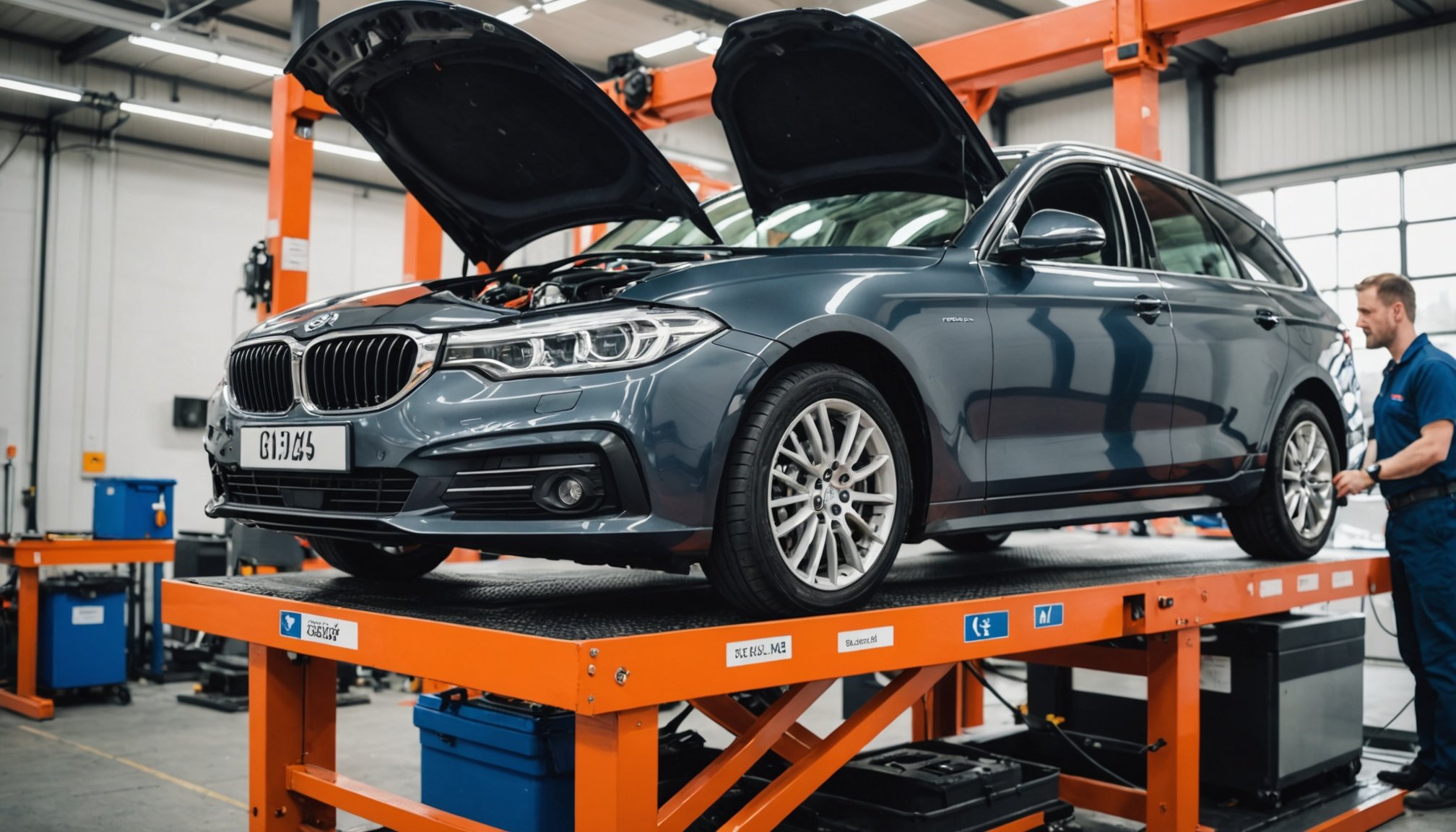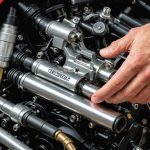Understanding Vehicle Wheel Alignment
Vehicle wheel alignment plays a crucial role in ensuring optimal vehicle performance. It involves adjusting the angles of the wheels so they are set to the car manufacturer’s specifications. Precise alignment helps maintain the vehicle’s direction, enhances the control and safety of the car, and promotes even tire wear. Notably, it’s a critical aspect when considering the longevity of your tires and the economy of your vehicle.
Technically, wheel alignment affects how straight your vehicle runs. Poor alignment can cause the tires to wear unevenly and affect handling, leading to difficulties in steering. A properly aligned vehicle enhances fuel efficiency by reducing the resistance between the tire and the road.
Also read : Unlocking the secrets of uk company car fleet management: your ultimate guide to logistics success
There are common misconceptions about alignment, with many assuming it is only necessary after hitting a severe pothole. However, regular checks are advised, as everyday driving conditions can gradually lead to misalignment.
Understanding these elements can significantly impact not just your driving experience but also your vehicle’s running costs and environmental footprint. Regular comprehensive alignment checks enable drivers to preemptively address potential issues, thereby extending the lifespan of their tires and ensuring a smoother ride.
Have you seen this : Essential road trip prep: your complete guide to ready your vehicle for an unforgettable journey from the uk to europe
Symptoms Indicating Misalignment
Understanding the symptoms of misalignment in your vehicle is crucial to ensure safe and efficient driving. One of the most obvious signs is tire wear. If you notice uneven wear on your tires, such as more wear on the inside or outside edges, it could indicate that your wheels are not aligned correctly. This uneven wear reduces tire lifespan and affects vehicle grip and safety.
Steering issues are another common symptom. A misaligned vehicle may pull to one side, requiring constant steering correction to maintain a straight path. This not only makes driving tiring but also increases fuel consumption. You might also feel vibrations in the steering wheel, signaling potential alignment problems.
Unusual noises and vibrations are telltale indicators of misaligned wheels. If you hear squealing tires or feel vibrations through the steering wheel, alignment issues may be present. These symptoms often worsen with increasing speed, underscoring the need for prompt diagnosis and correction.
Addressing these symptoms early on is essential to maintain optimal vehicle performance. Regular inspections and alignment checks can prevent these issues from escalating, saving on costly repairs and ensuring a safe driving experience.
Diagnosing Wheel Alignment Issues
Diagnosing wheel alignment issues is essential for maintaining your vehicle’s safety and performance. Understanding when alignment problems arise can save time and money.
Preliminary Checks
Begin with a visual inspection. Walk around your car to spot uneven tire wear – a primary indicator of a misalignment. Checking the steering wheel’s position while driving straight can reveal off-center tendencies, another misalignment sign.
Tools for DIY Diagnosis
To delve deeper, DIY methods can be handy. Basic tools such as a tape measure and a laser alignment tool are useful. By measuring tire toe-in and toe-out, these tools offer insights into alignment status. Remember that DIY checks serve as preliminary assessments and may not replace professional evaluations.
When to Seek Professional Help
Noises or extreme handling difficulties may necessitate expert evaluation. Professional alignment services ensure precision, offering adjustments that home methods might miss. Persistent symptoms or after hitting a pothole should prompt a visit to a garage. Professional assessments leverage specialised tools and expertise, ensuring comprehensive diagnosis and correction of issues.
By combining simple in-home checks with professional services when necessary, you help preserve your vehicle’s performance, ensuring safer, smoother journeys.
Professional Alignment Services in the UK
Accessing professional alignment services in the UK ensures that your vehicle’s wheels are positioned perfectly for optimal performance. These services typically involve an expert adjusting the camber, caster, and toe angles of each wheel to meet precise manufacturer specifications. This attention to detail can prevent unnecessary tire wear, enhance driving comfort, and improve safety.
When considering alignment services, it’s crucial to understand that costs can vary. Factors influencing prices include the complexity of the service, type of vehicle, and even the garage’s region. Generally, larger vehicles might require more intricate adjustments, thus increasing the overall cost.
Choosing the right garage for alignment jobs involves more than just price considerations. Look for UK garages with a strong reputation and certified technicians experienced in alignment tasks. Recommendations from fellow drivers can also guide you towards finding reliable service providers.
In summary, regular alignment checks by professionals safeguard your vehicle’s performance and efficiency. Keeping an eye on alignment also aids in reducing running costs, as well-aligned wheels contribute to better fuel economy and prolonged tire life. Taking advantage of professional expertise can lead to safer, smoother driving experiences throughout the diverse road conditions of the UK.
Factors Affecting Wheel Alignment for UK Drivers
Understanding the factors affecting alignment can help UK drivers maintain optimal vehicle performance. The state of UK road conditions is a significant contributor. Potholes, uneven surfaces, and frequent speed bumps can disturb your vehicle’s alignment. Regular exposure to such conditions calls for frequent alignment checks to offset the impact.
Different vehicle types require distinct alignment considerations. Sports cars, for instance, benefit from a different alignment setup compared to SUVs or commercial vehicles. The weight distribution and suspension settings vary, which can affect alignment requirements.
Seasonal factors, such as wet and icy roads during autumn and winter, can also influence alignment. Wet conditions increase the slip risk, possibly altering the wheel positions. Therefore, seasonal checks are advised to ensure alignment adjustments cater to changing grip and surface conditions.
Maintaining alignment awareness amidst these elements ensures safe and efficient driving. Adapting alignment practices to the specific demands of your vehicle type and the environment can lead to better handling and prolonged tire life. It is crucial for drivers in the UK to be proactive. Regular evaluations and considerate driving can mitigate the adverse effects these factors have on vehicle alignment.
Maintenance Tips to Prevent Future Alignment Issues
Keeping your vehicle’s alignment in check involves consistent attention and smart driving habits. Here are some alignment maintenance tips to help you maintain a smooth ride:
-
Routine Checks: Regularly schedule alignment inspections, especially after encountering potholes or rough terrain common in UK road conditions. Regular checks help catch early signs of misalignment.
-
Tire Care: Ensure that your tires are inflated to the vehicle manufacturer’s specifications. Properly inflated tires reduce the risk of uneven tire wear and subsequently, misalignment. Rotate tires as per the vehicle’s maintenance schedule to promote uniform wear.
-
Smart Driving: Avoid sudden impacts with curbs or driving over obstacles. Gentle handling and avoiding high speeds over speed bumps can minimise alignment disturbances.
-
Visual Inspections: Periodically examine your vehicle for visual signs of alignment issues, such as uneven tire wear. Taking these preventive measures enhances vehicle performance and prolongs tire life, offering a smoother, safer driving experience.
For UK drivers, adapting to local road conditions and integrating these practices into regular vehicle maintenance helps in avoiding potential alignment issues. These proactive measures not only ensure better handling and ride comfort but also contribute to overall vehicle longevity.
Conclusion and Recommendations
Considering the aspects discussed on vehicle wheel alignment, maintaining regular checks and adjustments is indispensable for both vehicle performance and safety. Embracing a proactive approach ensures optimal tire health, steering precision, and overall driving comfort. Adhering to the alignment service recommendations will undoubtedly yield long-term benefits.
Reputable UK Alignment Professionals
Finding reliable alignment professionals can make a significant difference. Seek out services like Kwik Fit, ATS Euromaster, or Halfords Autocentres for comprehensive evaluations. These garages are known for using advanced equipment that guarantees precision. Customer reviews highlight professionalism and expertise in handling diverse vehicle needs.
Post-Service Alignment Maintenance
After receiving alignment services, maintaining proper alignment requires attention to day-to-day driving habits.
- Avoid sudden impacts with curbs or potholes, common on UK roads.
- Regularly inspect tire pressure to avoid wear.
- Follow scheduled tire rotations to ensure balanced tread wear.
By being vigilant and committed to these practices, UK drivers can anticipate greater alignment longevity, reducing unexpected costs while enhancing safety. Prioritising alignment care not only extends tire life but also ensures a smoother, more controlled drive across Britain’s varied terrain.











